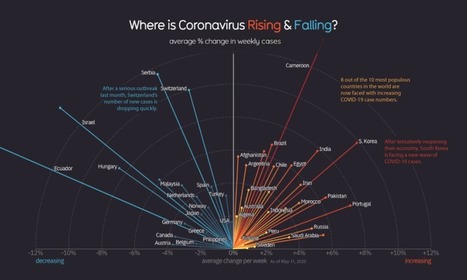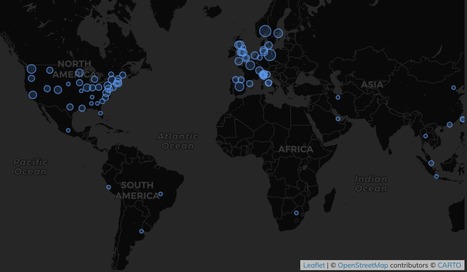 Your new post is loading...

|
Scooped by
Juan Lama
|
COVID-19 is caused by the coronavirus SARS-CoV-2, which jumped into the human population in late 2019 from a currently uncharacterised animal reservoir. Due to this recent association with humans, SARS-CoV-2 may not yet be fully adapted to its human host. This has led to speculations that SARS-CoV-2 may be evolving towards higher transmissibility. The most plausible mutations under putative natural selection are those which have emerged repeatedly and independently (homoplasies). Here, we formally test whether any homoplasies observed in SARS-CoV-2 to date are significantly associated with increased viral transmission. To do so, we develop a phylogenetic index to quantify the relative number of descendants in sister clades with and without a specific allele. We apply this index to a curated set of recurrent mutations identified within a dataset of 46,723 SARS-CoV-2 genomes isolated from patients worldwide. We do not identify a single recurrent mutation in this set convincingly associated with increased viral transmission. Instead, recurrent mutations currently in circulation appear to be evolutionary neutral and primarily induced by the human immune system via RNA editing, rather than being signatures of adaptation. At this stage we find no evidence for significantly more transmissible lineages of SARS-CoV-2 due to recurrent mutations. SARS-CoV-2 has emerged recently and may still adapt to the human host. Here the authors show that none of the so far identified recurrent mutations in SARS-CoV-2 are significantly associated with increased viral transmission. Published in Nature (Nov. 25, 2020): https://doi.org/10.1038/s41467-020-19818-2

|
Scooped by
Juan Lama
|
As much of western Europe begins to ease countrywide lockdowns, globally the pandemic may still be in its infancy, with more than 160 000 new cases reported each day since June 25. Individual countries count cases differently, so direct comparisons are difficult, but the numbers illustrate a worrying pattern. At a subnational level the picture is nuanced, with local hotspots, but at a country level the picture is clear—the world is facing a worsening multipolar pandemic. The USA, Brazil, and India each logged more than 100 000 new cases from June 26 to July 3. But the pandemic also rages in Russia, forming a belt of infection that tracks through central Asia and into the Middle East and the Indian subcontinent. Increasing COVID-19 cases in South Africa mean that the pandemic has a strong foothold in sub-Saharan Africa, which is particularly alarming as parts of Africa consider resuming internal air travel later this month. Despite President Trump's July 4 claims that “99% of cases are harmless” and of a “strategy that is moving along well”, the USA has the most new cases worldwide—53 213 on July 4, and a total of 128 481 deaths, almost a quarter of the total deaths globally. These beacons of infection show the fragility of any progress. During the first days of July, 2020, Kazakhstan recorded the second highest number of new cases within Europe after Russia. Reporting in the largely authoritarian central Asian states has been unreliable. Turkmenistan has yet to report a single case of COVID-19 and Tajikistan has yet to provide breakdowns to WHO. Regardless, the health and economic outlook for the region is bleak. These countries have some of the highest ratios of out-of-pocket health-care spending to total health expenditure in the world, with women in particular having very poor access to health care, further obscuring the true numbers of COVID-19 cases. At the beginning of the pandemic, 2·7 million to 4·2 million central Asian labour migrant workers were estimated to be residing in Russia. Many remain stranded in areas with a high infection risk, meaning reintroduction of the virus might become a problem after the initial wave. Published in The Lancet (July 11, 2020):

|
Scooped by
Juan Lama
|
Globally, the curve of COVID-19 cases is flattening, but individual countries vary considerably as new pockets of the world deal with the pandemic. It’s been just over two months since New York declared a state of emergency, and global stock markets were hammered as the fears of a full-blown crisis began to take hold. Since then, we’ve seen detailed, daily coronavirus coverage in most of the major news outlets. With such a wealth of information available, it can be hard to keep track of the big picture of what’s happening around the world. Today’s graphic, adapted from Information is Beautiful, is an efficient look at where the virus is fading away, and where new infection hotspots are emerging. First, the good news: the number of new confirmed COVID-19 cases has started to level off on a global basis. This metric was rising rapidly until the beginning of April — but since then, it has plateaued and is holding steady (for now). Of course, the global total doesn’t tell the whole story. Different countries, and even regions within countries, are in very different phases of dealing with the pandemic.
|

|
Scooped by
Juan Lama
|
The presentation summarizes the global efforts of W.H.O. to support the development, test, and manufacture of COVID-19 vaccine in record times. The time for approval of a vaccine averages 10 years. However, the process is expected to be reduced by more than 5 times for COVID-19. This presentation, updated as of October 6, 2020, summarizes the W.H.O. global efforts towards this goal, and also provides and excellent summary of the vaccine development process. As of today, at least 213 COVID-19 vaccines are under development, including 178 preclinical candidates and 35 vaccines in human trials. Nine vaccines have already entered advanced Phase III trials. With typical approval rates of 7% for preclinical candidates, and 20% for those entering human trials, more than 30 vaccines against SARS-CoV-2 could be approved in the following years, and about two of them in the following months.

|
Scooped by
Juan Lama
|
How Covid-19 has affected health and economics around the world? Nearly every nation on earth is struggling to reopen its economy safely while continuing to battle the coronavirus. But some are doing better than others. We’ve mapped the performance of 30 leading countries by plotting their health and economic outcomes and grouping them based on whether they have instituted light, moderate or severe restrictions on commerce and social interactions. The coronavirus pandemic has spread across countries at different times, and each has responded differently depending on their health and political systems, as well as their economies. Despite some bright spots, nearly every country presents a mixed picture. This matrix considers countries' bottom lines when it comes to infections, deaths, GDP and unemployment, as well as how those metrics were shaped by specific government interventions. Germany, for example, has diverse but relatively bad outcomes overall. Its economy is sinking at the same rate as its neighbors, but its death rate is significantly lower than theirs, thanks to widely lauded testing and health care.That said, Berlin’s official count of Covid-19 deaths in nursing homes is both slow and patchy. Some countries test widely (Iceland) and count all possible Covid-19 deaths (Belgium), skewing their numbers compared to less transparent countries (Russia). New Zealand and Sweden took opposite approaches to restricting their populations’ movement and have very different health outcomes, but nearly identical recessions. Several countries have similar GDP numbers but starkly different unemployment rates (the U.S., the U.K. and Japan), a function of whether the government guarantees workers’ salaries. India avoided overwhelming its fragile health system via the world’s biggest lockdown, but that, in turn, tanked its economy, which might contract 45 percent this quarter. Taiwan, meanwhile, did nearly everything right in terms of its response to the health crisis, but can’t escape the fact that 70 percent of its GDP comes from hard-hit export sectors.....

|
Scooped by
Juan Lama
|
Given the accelerated rate at which trial information and findings are emerging, an urgent need exists to track clinical trials, avoid unnecessary duplication of efforts, and understand what trials are being done and where. In response, we have developed a COVID-19 clinical trials registry to collate all trials. Data are pulled from the International Clinical Trials Registry Platform, including those from the Chinese Clinical Trial Registry, ClinicalTrials.gov, Clinical Research Information Service - Republic of Korea, EU Clinical Trials Register, ISRCTN, Iranian Registry of Clinical Trials, Japan Primary Registries Network, and German Clinical Trials Register. Both automated and manual searches are done to ensure minimisation of duplicated entries and for appropriateness to the research questions. Identified studies are then manually reviewed by two separate reviewers before being entered into the registry. Concurrently, we have developed artificial intelligence (AI)-based methods for data searches to identify potential clinical studies not captured in trial registries. These methods provide estimates of the likelihood of importance of a study being included in our database, such that the study can then be reviewed manually for inclusion. Use of AI-based methods saves 50–80% of the time required to manually review all entries without loss of accuracy. Finally, we will use content aggregator services, such as LitCovid, to ensure our data acquisition strategy is complete. With this three-step process, the probability of missing important publications is greatly diminished and so the resulting data are representative of global COVID-19 research efforts. Published in The Lancet (April 24, 2020) https://doi.org/10.1016/S2589-7500(20)30086-8 Clinical Trial Registry Site: https://www.covid-trials.org/
|



 Your new post is loading...
Your new post is loading...












